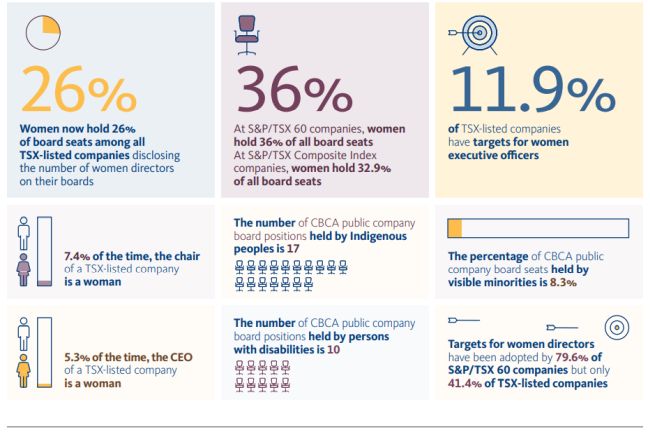Introduction
After eight years, the change to board composition in Canada is now obvious and widespread as Canadian boards have surpassed several important diversity milestones on their journey to include more diverse perspectives in decision-making at senior levels within the organization. There is still much work to be done to achieve board and executive leadership that reflects the mosaic of Canada, but in this, our eighth annual comprehensive report on diversity disclosure practices in Canada, we take a moment to recognize the significant progress that has been made.
Our report provides detailed disclosure on the representation of women in senior leadership positions at TSX-listed companies as well as the representation of women, members of visible minorities, Indigenous peoples and persons with disabilities at publicly-traded corporations governed by the Canada Business Corporations Act (CBCA). We also highlight disclosed best practices to improve diversity and inclusion and samples of excellence in disclosure.
Halfway to parity
Across all TSX-listed companies, more than one in every four directors is female as women now hold 26% of the board seats. This is a significant change from 2015 when we reported women on average represented 10% of the number of directors.
Looking at larger issuers, the news is even more encouraging. One-third of all board seats among the S&P/TSX Composite Index companies are held by women, and among the S&P/TSX 60 companies women hold 36% of all board seats.
At the same time, single gender boards have become an anachronism. For the first time, there are no all-male boards among the S&P/TSX Composite Index companies and none of the S&P/TSX 60 companies has less than two female directors. Across all TSX-listed companies only 11.6% of boards have no women directors, compared to 47.1% in 2015.
It has taken a keen and deliberate focus on recruiting women directors to get to this stage. This focus is reflected in high levels of adoption of board diversity policies and, in recent years, the adoption of targets for women directors. These efforts resulted in 43.6% of new board positions being filled with women candidates last year. Institutional investor pressure to increase diversity has been a key driver of change.
10% of all directors reflect diversity beyond gender
Based on Canada's experience with disclosure requirements relating to the representation of women in senior leadership, achieving diversity with respect to characteristics beyond gender will take time. However, change has begun. Across all CBCA corporations, just under 10% of board positions are held by directors who are members of visible minorities, Indigenous peoples or persons with a disability.
Some small progress in building the pipeline
Every year we have highlighted the lack of any meaningful progress in increasing the proportion of women executive officers among TSX companies, and in recent years we have noted the lack of representation of visible minorities, Indigenous peoples or persons with a disability among executive officers. However, as we note in our report this year a significant majority of executive teams today include at least one woman and one in every five executive officers (19.8%) is a woman. This represents a significant improvement from 2015 when women accounted for only 13.5% of the executive officer positions on average. And this year we have started to see some progress in the number of executive officers who are visible minorities, Indigenous peoples or persons with a disability.
More to come
Eight years is a long time to achieve the milestones that have been reached to date. And it will take considerable, sustained effort to achieve gender parity and representation by other diverse groups that approximates the demographics of the population in Canada. We hope that the disclosure and best practices highlighted in our report will help companies in their diversity, equity and inclusion journeys
Highlights

The Diversity Disclosure Requirement
The Diversity Disclosure Requirement requires disclosure:
- Whether or not the issuer has adopted a written policy relating
to the identification and nomination of women directors. If the
issuer has not adopted such a policy, it must disclose why it has
not done so. If an issuer has adopted a policy, the issuer must
disclose:
- a short summary of its objectives and key provisions
- the measures taken to ensure that the policy has been effectively implemented
- annual and cumulative progress by the issuer in achieving the objectives of the policy
- whether, and if so how, the board or its nominating committee measures the effectiveness of the policy
- Whether the issuer considers the level of representation of women on the board in identifying and nominating candidates for election or re-election to the board. If so, the issuer must disclose how and, if not, disclose the issuer's reason for not doing so.
- Whether the issuer considers the level of representation of women in executive officer positions when making such appointments. If so, the issuer must disclose how and, if not, disclose the issuer's reason for not doing so.
- Whether the issuer has adopted a target regarding the appointment of women to the board. If so, the issuer must disclose the target and the annual and cumulative progress of the issuer in achieving the target. If not, the issuer must disclose the reason for not doing so.
- Whether the issuer has adopted a target regarding women in executive officer positions of the issuer. If so, the issuer must disclose the target and the annual and cumulative progress of the issuer in achieving the target. If the issuer has not adopted a target, it must disclose why it has not done so.
- The number and percentage of women on the issuer's board of directors.
- The number and percentage of the issuer's women executive officers, including all major subsidiaries of the issuer.
CBCA Requirement
The CBCA Requirement requires substantially the same disclosure as the Diversity Disclosure Requirement, but separately with respect to each “designated group” – which it defines to include, but not be limited to, designated groups as defined by the Employment Equity Act (Canada).
Accordingly, disclosure is required with respect to
- women
- Indigenous peoples (First Nations, Inuit and Métis)
- persons with disabilities
- members of visible minorities.
Companies subject to the CBCA Requirement may also elect (but are not required) to provide disclosure in respect of additional “designated groups” identified in their information circulars.
We recognize that there are a range of terms used to reference the various diversity characteristics referred to in this report. Different companies make different choices in this regard. Since our report is based on disclosure made by companies in response to legislated disclosure requirements, we have generally used the same terms as the legislation where applicable to avoid confusion. However, we have chosen to use the term ‘Indigenous peoples' to include references to Indians, Inuit and Metis peoples covered by the term ‘Aboriginal peoples' in the legislation referenced by the CBCA Requirement.
To view the full article, click here
The content of this article is intended to provide a general guide to the subject matter. Specialist advice should be sought about your specific circumstances.



